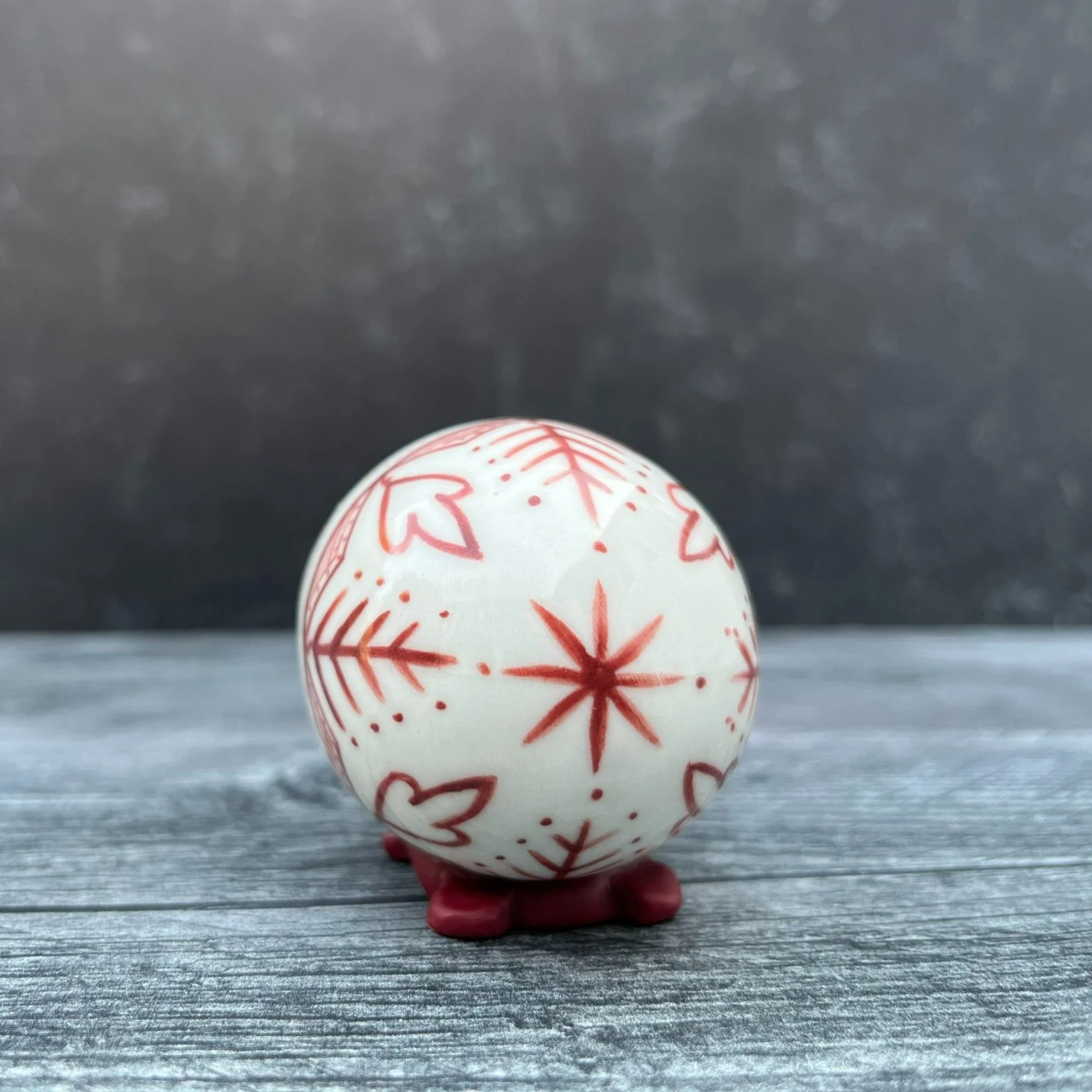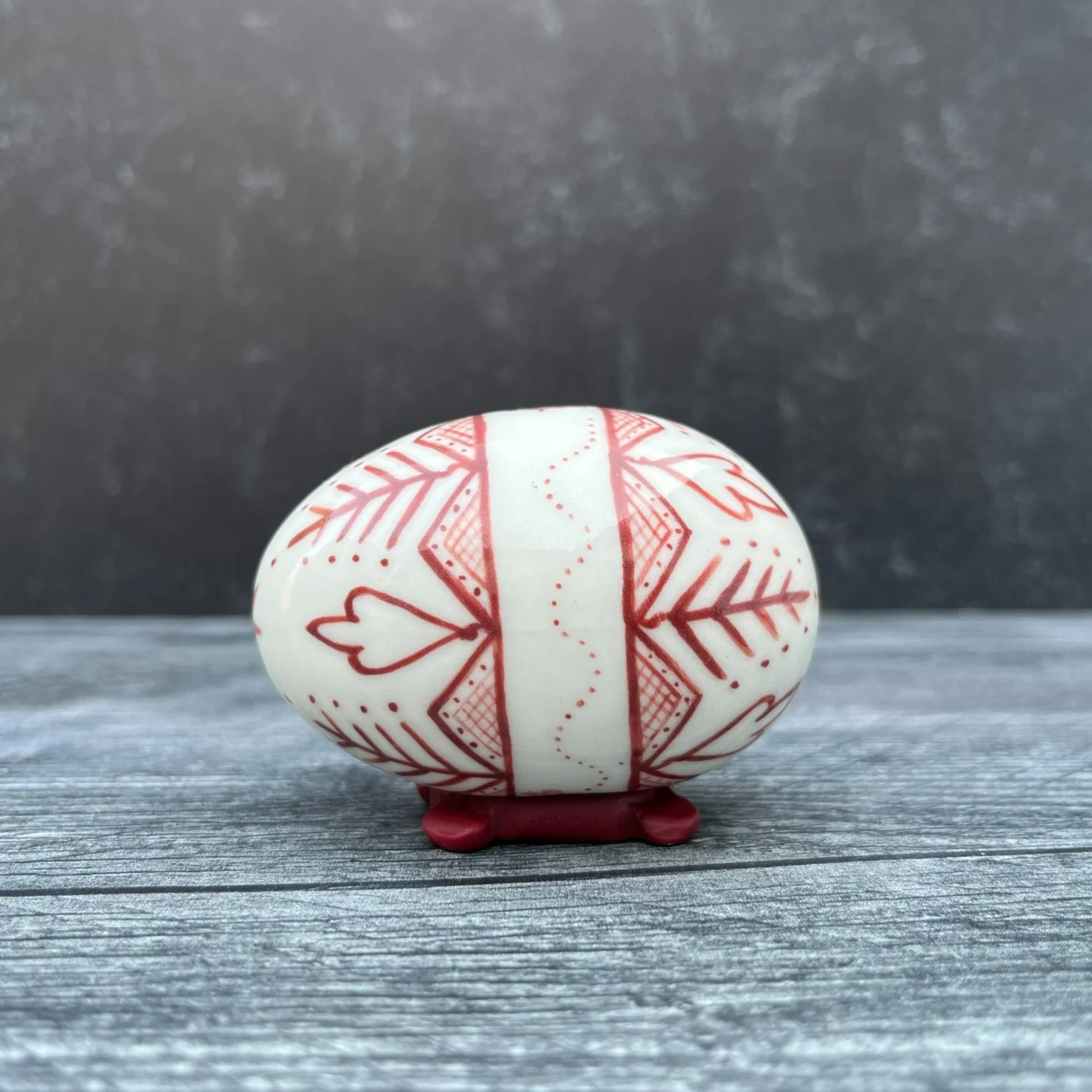 Image 1 of 7
Image 1 of 7

 Image 2 of 7
Image 2 of 7

 Image 3 of 7
Image 3 of 7

 Image 4 of 7
Image 4 of 7

 Image 5 of 7
Image 5 of 7

 Image 6 of 7
Image 6 of 7

 Image 7 of 7
Image 7 of 7








"Vasilisa the Beautiful" Porcelain Folklore Egg
The Folklore collection of porcelain eggs draws inspiration from Pysanky, a tradition of egg decorating in Ukrainian culture that originated in Pagan times. This hand-painted porcelain egg uses traditional pysanky motifs to tell the tale of Vasilisa the Beautiful, a Russian folktale about a brave young girl who survives the fearsome witch Baba Yaga with the help of her enchanted doll and her own inner strength. Vasilisa journeys into the dark forest and emerges not only unharmed, but empowered—carrying with her a glowing skull lantern that reveals truth and banishes evil.
At the center of the design is Vasilisa herself, holding the glowing skull lantern—a symbol of hard-won wisdom and protection. She is surrounded by tripod motifs, traditional pysanky symbols of various trinities such as the natural elements, the life cycle, or the family unit. Framing this is a border of wolves’ teeth in the shape of a diamond or open jaw—a row of sharp triangles that represents danger and evil in the world. Alternating teeth are filled with a resheto design, a crosshatched net motif believed to protect from evil spirits. This symbol dates back to Paleolithic goddess worship and transforms the egg into a talismanic object—meant not only to tell a story, but to offer protection and power.
Outside the central border, sheaves of wheat curve along the surface—a symbol of labor, sustenance, and life’s work, commonly seen in diasporan pysanky. At the top and bottom of the egg, radiant ruzha star motifs bloom in the Poltava, or poppy, style. These geometric eight-pointed stars, placed with an equatorial division as storchova ruzha, serve as compass points—solar symbols of endurance, growth, and guidance.
On each side of the egg, rows of three horses gallop across the surface, representing the three riders Vasilisa meets—mysterious figures who mark the passage of morning, noon, and night.
Rich in story, symbol, and intention, this egg is both heirloom and amulet—a vessel of folklore, feminine resilience, and ancient protective power.
The egg measures approximately 2.5 inches in length.
The Folklore collection of porcelain eggs draws inspiration from Pysanky, a tradition of egg decorating in Ukrainian culture that originated in Pagan times. This hand-painted porcelain egg uses traditional pysanky motifs to tell the tale of Vasilisa the Beautiful, a Russian folktale about a brave young girl who survives the fearsome witch Baba Yaga with the help of her enchanted doll and her own inner strength. Vasilisa journeys into the dark forest and emerges not only unharmed, but empowered—carrying with her a glowing skull lantern that reveals truth and banishes evil.
At the center of the design is Vasilisa herself, holding the glowing skull lantern—a symbol of hard-won wisdom and protection. She is surrounded by tripod motifs, traditional pysanky symbols of various trinities such as the natural elements, the life cycle, or the family unit. Framing this is a border of wolves’ teeth in the shape of a diamond or open jaw—a row of sharp triangles that represents danger and evil in the world. Alternating teeth are filled with a resheto design, a crosshatched net motif believed to protect from evil spirits. This symbol dates back to Paleolithic goddess worship and transforms the egg into a talismanic object—meant not only to tell a story, but to offer protection and power.
Outside the central border, sheaves of wheat curve along the surface—a symbol of labor, sustenance, and life’s work, commonly seen in diasporan pysanky. At the top and bottom of the egg, radiant ruzha star motifs bloom in the Poltava, or poppy, style. These geometric eight-pointed stars, placed with an equatorial division as storchova ruzha, serve as compass points—solar symbols of endurance, growth, and guidance.
On each side of the egg, rows of three horses gallop across the surface, representing the three riders Vasilisa meets—mysterious figures who mark the passage of morning, noon, and night.
Rich in story, symbol, and intention, this egg is both heirloom and amulet—a vessel of folklore, feminine resilience, and ancient protective power.
The egg measures approximately 2.5 inches in length.
The Folklore collection of porcelain eggs draws inspiration from Pysanky, a tradition of egg decorating in Ukrainian culture that originated in Pagan times. This hand-painted porcelain egg uses traditional pysanky motifs to tell the tale of Vasilisa the Beautiful, a Russian folktale about a brave young girl who survives the fearsome witch Baba Yaga with the help of her enchanted doll and her own inner strength. Vasilisa journeys into the dark forest and emerges not only unharmed, but empowered—carrying with her a glowing skull lantern that reveals truth and banishes evil.
At the center of the design is Vasilisa herself, holding the glowing skull lantern—a symbol of hard-won wisdom and protection. She is surrounded by tripod motifs, traditional pysanky symbols of various trinities such as the natural elements, the life cycle, or the family unit. Framing this is a border of wolves’ teeth in the shape of a diamond or open jaw—a row of sharp triangles that represents danger and evil in the world. Alternating teeth are filled with a resheto design, a crosshatched net motif believed to protect from evil spirits. This symbol dates back to Paleolithic goddess worship and transforms the egg into a talismanic object—meant not only to tell a story, but to offer protection and power.
Outside the central border, sheaves of wheat curve along the surface—a symbol of labor, sustenance, and life’s work, commonly seen in diasporan pysanky. At the top and bottom of the egg, radiant ruzha star motifs bloom in the Poltava, or poppy, style. These geometric eight-pointed stars, placed with an equatorial division as storchova ruzha, serve as compass points—solar symbols of endurance, growth, and guidance.
On each side of the egg, rows of three horses gallop across the surface, representing the three riders Vasilisa meets—mysterious figures who mark the passage of morning, noon, and night.
Rich in story, symbol, and intention, this egg is both heirloom and amulet—a vessel of folklore, feminine resilience, and ancient protective power.
The egg measures approximately 2.5 inches in length.





























